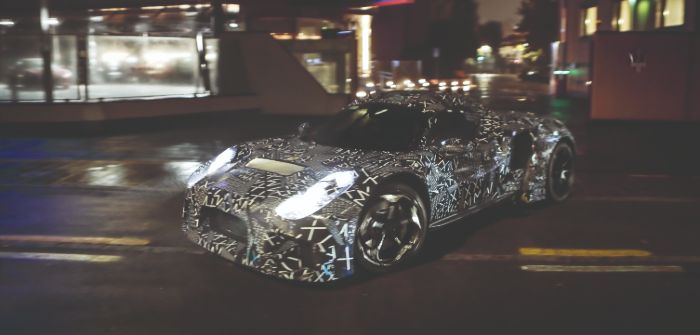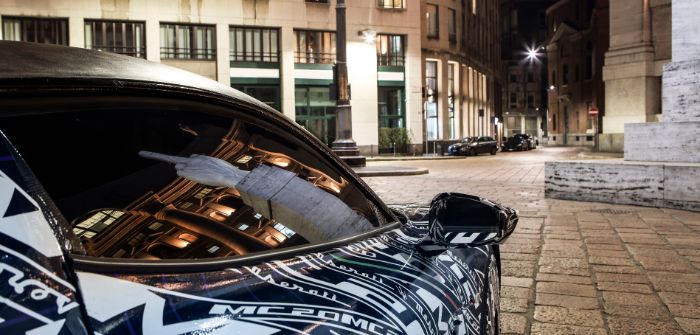Although volumes are likely to be relatively small, Maserati has a lot riding on its forthcoming supercar. The MC20 not only fills the gap in the product range left by the MC12 15 years ago, but debuts the brand’s new in-house engine, ramps up its electrification plans and takes it back into professional motorsport. It wasn’t only the high expectations that made its two-year development program challenging, however.
The project kicked off in 2018 under Federico Landini, vehicle line executive for sport vehicles. An FCA Group engineer of 20 years, first at Ferrari but latterly having worked on almost every product in the current Maserati range, it was the whiteboard in his office where the initial cornerstones were set out. This included not only road-going performance and comfort criteria, but also the flexibility to meet the requirements of the race series it will eventually compete in.
“The idea was to do something impressive, to be a milestone and remain a milestone as the MC12 was,” Landini explains. “The entire vehicle is designed from scratch, and it’s a completely new architecture – the most similar vehicle we developed was 15 years ago. What we have taken from the past is only some ideas in terms of vision. The Maserati MC12 was a visionary vehicle, but we have not used any [shared] components.”
Most of the development program took place in Modena, not only home to the plant where the MC20 will be built, but to Maserati’s Innovation Lab, which opened in 2015. The facility employs around 1,100 engineers and has expanded with heavy recruitment drives from Italy’s very best technical universities. It features cutting-edge simulation capabilities which Landini claims were crucial for accelerating development, particularly during the program’s early stages. Digital models enabled the composite-rich chassis to be optimized for stiffness and crash performance, and for engineers to focus in on handling characteristics before physical prototypes had even been constructed.
“Those simulations are helping us even now we are running all the test on the track,” continues Landini. “It’s helping us to make quick decisions, because we can swap easily from one setup to another, finalize the number of tests that we want to do on the track and concentrate on the target.
“Simulation technology is offering us the possibility to do quicker, faster, different setup of the vehicle. You can choose, from over 1,000 configurations, three or four that you want to test on the track. The final setup needs to be done from our experience on the track or on the amazing roads that we have all around Modena.”
Prototype to production
Development of physical components focused at first on the powertrain. Maserati will offer a battery-electric version of the MC20, alongside its new 630hp twin-turbo Nettuno V6 gasoline engine – the company’s first in-house engine program in 20 years, using what’s claimed to be the very first pre-chamber combustion system on a road car. The monocoque is identical for both powertrains, Landini notes, and differs completely to anything else in the range.
“We started to have the first mules for the powertrain in 2019, around the end of the summer. It was a specific design, because there’s no vehicle in our range that will accept this new powertrain. We have taken some of the components from other vehicles, but we have designed the chassis and body from scratch. So there was a big effort from our side because we have [effectively] designed two vehicles.”
The first full MC20 prototypes followed in January, and around 100 have been constructed in Modena since, at varying technological levels depending on build date and purpose. Test locations were familiar from other vehicles, including track testing at FCA’s facility in Bolocco, and at Nardò and the Nürburgring. MC20’s track testing was overseen by former GT1 championship winner turned Maserati test driver Andrea Bertolini, who was also involved in the development of the MC12.
“We have also introduced testing at some grand prix test tracks, which is not common for our vehicles,” adds Landini. “For our own tests we are lucky because here in Motor Valley we have some of the most famous roads in the world to test the vehicle. We are using these roads in physical testing, and also in the simulator.”
This on-road testing process is ongoing. Endurance testing was undertaken in the USA, and switching between hemispheres has enabled year-round hot and cold testing. Landini believes “a few million” collective kilometers of physical tests will have been carried out by the time the first cars reach customers early next year.
Data taken from prototype drives is enabling notably better correlated HIL simulations, allowing more iterations of mechanical and bodywork tuning to take place in a shorter timeframe. This also proved important as Covid-19 lockdowns required both in-house engineers and suppliers to quickly adopt remote working during the final phases of the project. Simulation, including a virtual test driver, enabled fine-tuning to continue while most of Europe was shut down.
Landini says that almost all of the development process can be carried out in simulation, particularly in terms of handling characteristics, but adds that physical tests remain important for performance cars. During these final stages, around half of the work is undertaken virtually, working hand in hand with teams on the road. Fine-tuning of handling, NVH, driveability and shift patterns is still difficult to simulate, he says, and still requires validation with prototype drives.
“Our first target with simulation is not to reduce the number of vehicles or save money, but to increase speed and productivity of the engineers. For example, for the MC20’s handling we completed 98% of the hardware development in the simulator, then we moved to the physical vehicle to finalize the [remaining] 2%. It gives our customers the feeling of finely tuned dynamics and comfort that is not possible in the simulator.”
In the meantime, Maserati is working closely with its suppliers to ready the overhauled Modena factory for production – a process in which around 600 people are currently involved. The Modena site was chosen for its specialism in smaller-volume production, but has recently had a new paint shop constructed (removing the need to outsource painting to Ferrari) alongside adaptations to the line, including for the electric drivetrain. Having laid out the framework for its future race career, the company lists motorsport development as the next priority once the road version is ready.
“Despite the amount of work that we have done, we need to concentrate on the work that is remaining. We can say the job is done once we see the customer and stakeholders satisfied. That is the goal and main target for us at Maserati.”
Maserati’s electric era
Maserati is embarking on its electrification program with a hybrid version of the Ghibli and battery-electric GranTurismo and GranCabrio over the coming months, and the MC20 will mark a step forward for the technology. Landini claims this will incorporate next-gen battery tech with long-range and ultra-fast charging, as well as supporting tailored driving modes.
Simulation enabled Maserati to explore “hundreds of configurations” for weight distribution, powertrain characteristics and center of gravity early on. Prototypes of the electric MC20 were built at the start of 2020, using a powertrain developed at the Innovation Lab in Modena, and testing on road and track is ongoing. As an early electrified powertrain, data acquired from this process is invaluable not only for this vehicle but for other products too.
“You not only have to consider the constraint of the internal combustion engine powertrain, but you have to have vision. You need to introduce constraints that are totally different in terms of legality, distribution
of weight, balancing the power and the vehicle, as well as performing at the maximum level in electric and gasoline versions,” says Landini.
“From the electrification point of view, the development of the controls is really important. This is something that is introducing a lot of tests on the ground – you cannot simulate this very easily because it’s the first time that we are approaching this kind of work, and we have not correlated the model enough.
“It’s day by day work, going back and forth between the simulator, the road and the track, but we need to increase the correlation of our model. To work like we did 10 years ago only on the track, with this amount
of complexity in terms of controls, software and so on, is not the best configuration you can do today.”
Simulator selection
Static simulator
The starting point for all products, this comprises a vehicle cockpit with three projectors and high computational power for DIL testing and feedback. Early validation work, including the very first HIL tests for subsystems and characteristics, are undertaken here.
Dynamic simulator
Maserati’s bespoke Driver-in-Motion simulator is based on the OEM’s own proprietary controls, and designed to reduce the number of prototypes required by closely simulating the final product, enabling virtual sign-off. An underlying air cushion and nine actuators, as opposed to the usual six degrees of freedom, offer smooth, high-fidelity reproduction of driving dynamics on a variety of surfaces and environments. By enabling new configurations to ‘lap’ several race circuits within a single day and with settings adjusted in minutes, it’s claimed this simulator can halve time-to-market.
User eXperience labs
Multisensory vehicle interactions are emulated in separate laboratories, streamlining HMI, driver assistance and electric drivetrain validation. The OEM says it can reproduce driving posture and visibility, and test distraction potential from controls, displays and audio warnings in these facilities. Simulation undertaken here includes development of vehicle ‘soundtracks’ and the ability to emulate lighting conditions for any location, time and season, enabling engineers to check for cabin reflections and glare.
By Alex Grant




